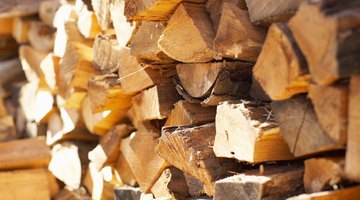Firewood Cover vs. Not Covered
For those with a fireplace or wood-burning stove, cutting and storing firewood is an important issue. Knowing the proper way to cut, stack and store firewood outdoors will provide long-burning wood throughout the winter.

When wood is stored improperly, it can rot, mold or deteriorate quickly, so stack and protect firewood correctly.
Fresh Firewood
It is easiest to split freshly cut logs, so wood thicker than 8 inches in diameter should be split into logs soon after cutting. However, freshly cut wood needs to dry completely before it is burned. A wood stack of freshly cut wood should not have any covering over it to allow the firewood to dry out completely. Covering fresh wood will create condensation on the tarp or plastic covering and cause the wood to mold and rot. Since the wood cannot be burned, it doesn't matter that it gets rain or snow on it.
Seasoned Firewood
If firewood is seasoned, dry and ready to burn, then it should have a tarp over the top of the stack to protect it from the elements. However, do not cover the sides of the stack with a tarp, or the wood may rot. Even after the wood is dry, the stack needs good air circulation to keep moisture out. Although it seems counter-intuitive, wood will stay drier with just the top covered than it would if the stack were covered all the way to the ground.
Sheds
A shed or lean-to is one of the best types of firewood cover. Even freshly cut wood can be stored under a lean-to or in a shed, allowing excellent circulation and preventing mold or rotting wood. Storing wood in an enclosed garage is less ideal, since the drying wood can create a musty smell in an enclosed building.
Tarps
For outdoor covering of wood stacks, use heavy-duty tarps with grommets. Tarps weather quickly when exposed to the elements constantly, so beginning with a heavy-duty tarp helps it last longer before it needs to be replaced. Stack wood neatly, off the ground to avoid insect infestations. Make a neat stack rather than a messy pile, since raccoons and other small animals will inhabit a loose pile, and such a pile is difficult to cover. Buy a tarp that is large enough to cover the top and just over the edge of the stack but does not cover more than half of the stack. Secure the tarp with bungee cords or nylon ropes attached to the grommets.
References
Writer Bio
Rachel Murdock published her first article in "The Asheville Citizen Times" in 1982. Her work has been published in the "American Fork Citizen" and "Cincinnati Enquirer" as well as on corporate websites and in other online publications. She earned a Bachelor of Arts in journalism at Brigham Young University and a Master of Arts in mass communication at Miami University of Ohio.
Photo Credits
- Jupiterimages/Photos.com/Getty Images
- Jupiterimages/Photos.com/Getty Images
More Articles



